Sold Ceramics
Sold Japanese Tea, Coffee and Chocolate wares 18th Century
Page 3
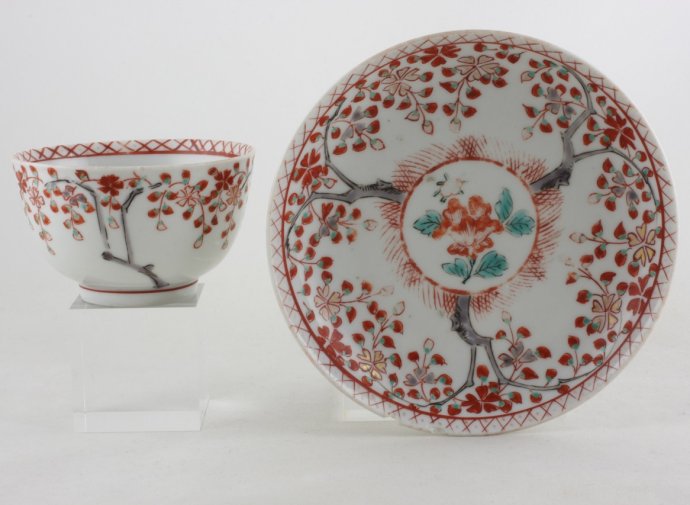
Sold Ceramics - Sold Japanese Tea, Coffee and Chocolate wares 18th Century - Page 3
Object 2012407
Teacup and saucer
Japan
Late 17th century
Height of teacup 41 mm (1.61 inch), diameter of rim 75 mm (2.95 inch), diameter of footring 33 mm (1.29 inch), weight 60 gram (2.11 ounce (oz.))
Height of saucer 25 mm (0.98 inch), diameter of rim 123 mm (4.84 inch), diameter of footring 72 mm (2.83 inch), weight 104 gram (3.67 ounce (oz.))
Teacup and saucer on footrings, straight rims. Decorated in iron-red, green, black and aubergine enamels and gold with a central roundel filled with a flower spray surrounded by grass motifs. On the cavetto three weeping cherry trees with dense flowers and foliage. Round the rim a border with x's. On the reverse rim a continuous floral scroll with an arrow floret on the base. The teacup is decorated en suite.
A similar teacup and saucer, bearing the Dresden inventory number N=93 with an arrow, is in the British Museum ((BM 1099) (Impey 2002, p.195, cat. 313)
For an identically shaped, sized and decorated teacup and saucer, please see:
Condition:
Teacup: A hairline and frit to the rim.
Saucer: Two chips to the rim, one with a connected hairline.
Reference:
Price: Sold.
More pictures of object 2012646, another identically shaped, sized and decorated, sold, saucer >>

Sold Ceramics - Sold Japanese Tea, Coffee and Chocolate wares 18th Century - Page 3
Object 2012010A
Saucer
Japan
1700-1720
Height 22 mm (0.86 inch), diameter of rim 118 mm (4.65 inch), diameter of footring 68 mm (2.68 inch), weight 93 grams (3.28 ounce (oz.))
Saucer on footring, slightly everted rim. Imari decorated in underglaze blue, iron-red and gold with a three-piece garniture on a horizontal band over a diaper pattern. The covered jar is decorated with floral designs and zig zag lines pattern borders, the vases are decorated with rows of dots. One of the vases is filled with branches of flowering chrysanthemum and carnation the other with branches of flowering peony and carnation. The reverse is decorated with three stylized flower sprays and three blue circles round the foot. On the base a single blue circle. Some kiln sand adhering to the base.
An identically shaped, sized and decorated teacup and saucer is in the Dresden collection (Johanneum mark 'N:108'' and signum '+'.). It was acquired July 1723 from Count Flemming. (Reichel 1981, p.150, cat. 52)
For this identically shaped, sized and decorated teacup and saucer in the Dresden collection, please see:
- Early Japanese Porcelain: Arita Porcelain in the Dresden Collection, (F. Reichel, Londen 1981), cat. 52.
- SKD Online collection, PO. 5049.
Jörg states that the use of garnitures as a decorative motif on tea ware was probably done as a suggestion of luxury, he illustrates it with a teacup and saucer decorated with an interesting five-piece garniture. A similar but simplified motif is seen on Delftware pieces, which were probably inspired by such Japanese examples. (Jörg 2003/1, pp.198-199, cat. 250)
For a teacup and saucer decorated with a five-piece garniture, please see:
Condition: Perfect.
References:
SKD Online collection, PO. 5049
Price: Sold.
More pictures of object 2012010C, another identically shaped, sized and decorated, sold, saucer >>
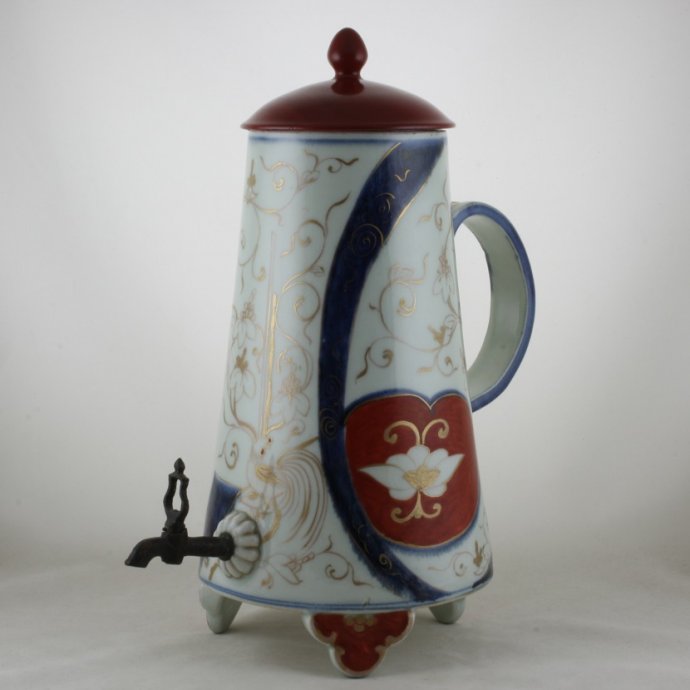
Sold Ceramics - Sold Japanese Tea, Coffee and Chocolate wares 18th Century - Page 3
Object 2012141
Coffee pot
Japan
1700-1720
Height with cover 315 mm (12.40 inch), height without cover 265 mm (10.43 inch), diameter handle to spout 265 mm (10.43 inch), diameter of mouthrim 90 mm (3.54 inch), diameter of footring 150 mm (5.91 inch), weight with cover 1,826 grams (64.41 ounce (oz.)), weight cover 88 grams (3.10 ounce (oz.))
Coffee pot of conical shape on three flat modelled feet. Curved, flat pierced handle, replaced wooden domed cover with pointed knob. The hole for the mounted Dutch brass tap in the lower part is surrounded by a kiku-flower modelled in low relief. Decorated in underglaze blue, iron-red and gold with two heart-shaped panels outlined in underglaze blue and filled with a flower-head on an iron-red ground. In between stylised flowers, foliage and a cockerel with a hen. On the handle florets between scrolls.
As was the case with tea, it was not until the end of the 17th century that drinking coffee became popular in Europe. each town had his own coffee house, where everyone - which in fact meant mainly men - could enjoy drinking a cup of coffee. The Dutch East India Company, (Vereenigde Oost-Indische Compagnie, VOC), started off mainly importing coffee from Yemen, experimenting only later with plantations of their own in Java.
However, drinking coffee had for centuries already been a common practice in the Middle East. European coffee pots were therefore often modelled after Islamic copper examples. Two types of coffee pots were most frequently commissioned in Asian porcelain: conical and belly-shaped. The conical shaped pot originally came from Japan. After brewed coffee was poured into this luxurious porcelain pot, it was held warm on a stand and subsequently served through a metal tap which had later been added to the pot after it had been imported to the Netherlands. At the bottom of the pot the coffee grounds were collected. Coffee pots from China, where both types were made, don't feature a tap but a spout. (The World at Home, exhibition Groninger Museum 17 june 2017 - 31 march 2019)
Coffee pots, usually three-legged, are common in blue-and-white and in enamelled Imari. Usually there is one hole left for a tap to be fitted in Europe, occasionally there are three. (Ayers, Impey & Mallet 1990, p.213)
For an identically shaped, sized and decorated coffee pot, please see:
Condition: Overall fine crazing to the glaze, a circular firing tension hairline, caused by the firing process, to the base and a glaze chip to the body.
References:
Ayers, Impey & Mallet 1990, p.213
Price: Sold.

Sold Ceramics - Sold Japanese Tea, Coffee and Chocolate wares 18th Century - Page 3
Object 2011725
Teapot
Japan
1700-1720
Height with cover 165 mm (6.50 inch), height without cover 117 mm (4.61 inch), diameter handle to spout 184 mm (7.24 inch), diameter of mouthrim 68 mm (2.68 inch), diameter of footring 59 mm (2.32 inch), weight with cover 526 grams (18.55 ounce (oz.)), weight cover 101 grams (3.56 ounce (oz.))
Globular teapot on a footring. Curved handle, straight spout. Domed cover with pointed knob. Imari decorated in underglaze blue, iron-red and gold with a richly filled flower vase on a shelf with an overhanging cloth. On each side of this vase a bird looking upwards. Round the shoulder an underglaze blue ground with a diaper pattern, flowerheads and four reserved panels alternately filled with a flowerpot or a river scene with a sailing boat, trees and mountains. Above the foot a lambrequin border with hanging tassels. On the handle and spout a floret between scrolls. The cover is decorated en suite.
The exceptional lambrequin with hanging tassels border design is the same as that on several Japanese armorial dinner and tea services, all dated early 18th century. Consequently, this teapot is dated accordingly.
A dinner and tea service belong to the Van Bambeeck family. In the Van Bambeeck tea service there are three identically shaped and sized teapots. Why there are three is not quite clear- usually only one teapot is included in a set. There may have been more identical sets, or it was a very large set used when serving many guests, or the owner upheld the tradition of giving each guest his own teapot. (Jörg 2003/1, pp. 233-235, cat. 297 & cat. 298)
For one of the three identically shaped and sized Van Bambeeck family armorial tea service teapots, including the lambrequin and hanging tassels border, please see:
The dinner and tea services of the Van Buren family as well as that with the Van Buren-Van Brederode family coat of arms, ordered for a marriage in 1702, are also decorated with this typical border design. (Jörg 2003/1, cat. 295, cat. 296 & cat. 296A)
For three armorial dinner and teaservices of Van Buren & Van Brederode with the same border design, please see:
The central decoration of the vase with two birds was probably copied from a European print or model and it is therefore remarkable that part of the flowers have been painted in underglaze blue, which required close cooperation with the enamellers. It is interesting to note, however, that the enamelled flowers have fancy shapes while the tulip-like underglaze blue ones are more realistic (Jörg 2003/1, p.238, cat. 303)
A less refined later dish with a different border design was made at the Gen'emon Kiln and can be found at the Koimari Museum in Arita, dated 1730-50, indicating a continuing interest in this decoration. (Arita 2000, p.52 cat. 80)
For the identically decorated dish, please see:
For the dish dated 1730-50 with the same design but different border, please see:
Condition: A restored end of the spout.
References:
Arita 2000, cat 80 & pp.160-161
Jörg 2003/1, cat. 295, 296, 296A, 297, 298 & 303
Price: Sold.
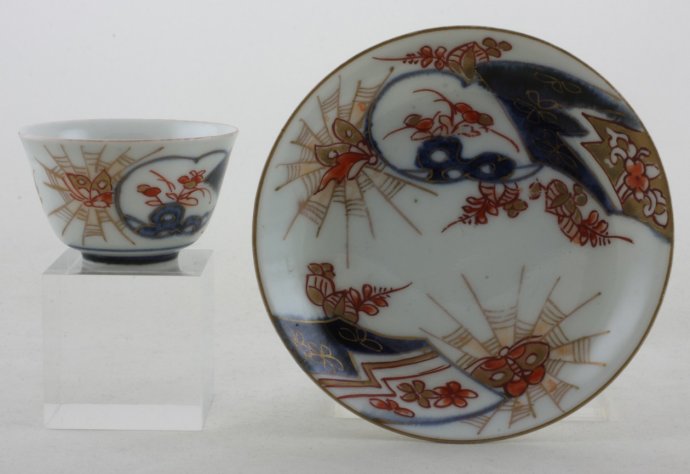
Sold Ceramics - Sold Japanese Tea, Coffee and Chocolate wares 18th Century - Page 3
Object 2012607
Tea bowl and saucer
Japan
1710-1730
Height of tea bowl 35 mm (1.38 inch), diameter of rim 55 mm (2.17 inch), diameter of footring 22 mm (0.87 inch), weight 26 grams (0.92 ounce (oz.))
Height of saucer 17 mm (0.67 inch), diameter of rim 103 mm (4.06 inch), diameter of footring 46 mm (1.81 inch), weight 47 grams (1.66 ounce (oz.))
Tea bowl and saucer on footring, slightly everted rims. Imari decorated in underglaze blue, iron-red and gold with irregular panels filled with flower sprays and butterflies on a cobweb. The reverse is undecorated. The tea bowl is decorated en suite.
Cobwebs are an unusual motif on Arita export ware. (Jörg 2003/1, p.199)
For an identically decorated teacup and saucer, please see;
For other objects decorated with a cobweb, please see:
Conditions:
Tea bowl: A popped bubble of glaze to the rim, due to the firing process.
Saucer: Perfect.
References:
Price: Sold.
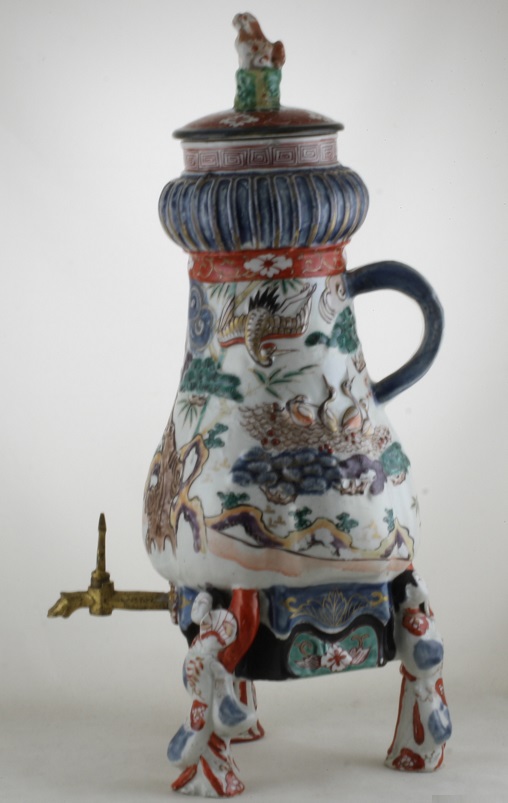
Sold Ceramics - Sold Japanese Tea, Coffee and Chocolate wares 18th Century - Page 3
Object 2012563
Coffee pot
Japan
1730-1750
Height with cover 410 mm (16.14 inch), height without cover 340 mm (13.39 inch), diameter of mouthrim 70 mm (2.76 inch), dimensions of base 105 mm (4.13 inch) x 105 mm (4.13 inch), weight with cover and tap 2,192 grams (77.32 ounce (oz.)), weight cover 126 grams (4.44 ounce (oz.)), weight tap 20 grams (0.71 ounce (oz.))
Coffee pot on three figural legs, curved flat handle, which is not pierced. European brass tap. The body is six-sided, lobed and narrows towards the neck, which is shaped as a broad, ribbed bulb with a straight mouthrim. The lower part is five-sided with an opening fitted with a brass tap. The base is unglazed and has textile imprint. On the domed cover the finial is modelled as a shi-shi. The decoration is moulded in relief and shows pine trees, bamboo, prunus, a nest with young cranes and their parents, painted in underglaze blue, pink-gold and various enamels. The three legs are moulded as Japanese women holding a fan.
This coffee pot is representative of a group of similarly moulded pieces, is difficult to date. It has clearly borrowed some basic elements such as the conical shape and the bulbous, lobed neck from a European model, probably a faience or pewter example, but the exact prototype with a comparable neck has yet to be traced. Although at first sight the modelling appears rather coarse, it is in fact carefully don, showing even the finest details. Pine, bamboo, and prunus are known as the 'Three Friends of Winter', and symbolise endurance, long life and happiness. The exuberant shape appealed to collectors in the late 19th century and consequently Samson copies were made that are still quite common. (Jörg 2003/1, p.207)
For an identically shaped and decorated coffee pot, please see:
- Fine & Curious: Japanese Export Porcelain in Dutch Collections, (C.J.A. Jörg, Hotei Publishing, Amsterdam 2003), p.207, cat. 266.
Condition: A frit to the rim.
References:
Price: Sold.
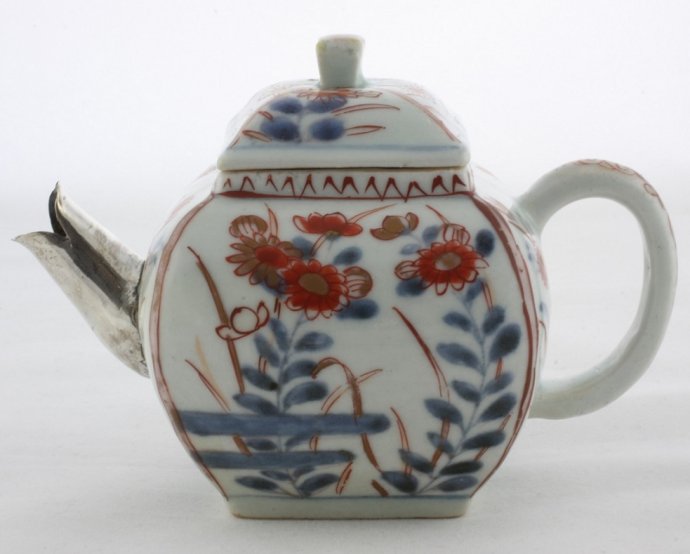
Sold Ceramics - Sold Japanese Tea, Coffee and Chocolate wares 18th Century - Page 3
Object 2010380
Teapot
Japan
1690-1720
Height with cover 85 mm (3.35 inch), height without cover 63 mm (2.48 inch), diameter handle to spout 125 mm (4.92 inch), dimensions of square mouthrim 38 mm (1.49 inch) x 38 mm (1.49 inch), diameter of footring: 40 mm (1.58 inch), weight with cover 183 grams (6.46 ounce (oz.)), weight cover 26 grams (0.92 ounce (oz.))
Square teapot with rounded sides on a low, square firing-ring. The lower body bulges before reverting to a square shape. A square shaped domed cover with a square knob finial. Curved handle and a short-broken spout fitted with an unmarked silver mount/spout. Imari decorated in underglaze blue, iron-red and gold. Greyish paste and greenish glaze. The sides decorated with two designs of flowering plants, each repeated opposite. Corners of body picked out with narrow red and gold lines. Round the square mouthrim a pointed leaves pattern border. On the handle a floret between scrolls. The red and gold lines continue from corners, dividing the cover onto four panels containing flowers similar to those on the body.
For identically decorated teapots, please see;
- Japanese Export Porcelain. Catalogue of the Collection of the Ashmolean Museum, Oxford, (O. Impey, Hotei Publishing, Amsterdam, 2002), p.207, cat. 344 and p. 208, cat. 347.
- Christie's Collections. Teapots, (P. Tippett, Marshall Editions, London, 1996), p. 20.
Condition: A restored handle, some crazing to the glaze of the lower part of the body and base.
References:
Price: Sold.

Sold Ceramics - Sold Japanese Tea, Coffee and Chocolate wares 18th Century - Page 3
Object 2011562
Coffee pot
Japan
1700-1720
Height with cover 330 mm (12.99 inch), height without cover 280 mm (11.02 inch), diameter handle to spout 252 mm (9.92 inch), diameter of mouthrim 91 mm (3.58 inch), diameter of footring 166 mm (6.54 inch), weight with cover 1,891 grams (66.70 ounce (oz.)), weight cover 93 grams (3.28 ounce (oz.))
Coffee pot of conical shape on three flat modelled feet. Curved, flat pierced handle, replaced wooden domed cover with pointed knob knob with a contemporary Dutch silver chain between the top of the handle and the cover. The hole for the mounted Dutch brass tap in the lower part is surrounded by a kiku-flower modelled in low relief. Dcorated in underglaze blue, iron-red and gold with four shaped panels filled with flowering plants and grasses in gold on an underglaze blue ground with scrolling foliage in gold.
The combination of the underglaze blue and golden decoration produces a splendid decorative effect.
As was the case with tea, it was not until the end of the 17th century that drinking coffee became popular in Europe. each town had his own coffee house, where everyone - which in fact meant mainly men - could enjoy drinking a cup of coffee. The Dutch East India Company, (Vereenigde Oost-Indische Compagnie, VOC), started off mainly importing coffee from Yemen, experimenting only later with plantations of their own in Java.
However, drinking coffee had for centuries already been a common practice in the Middle East. European coffee pots were therefore often modelled after Islamic copper examples. Two types of coffee pots were most frequently commissioned in Asian porcelain: conical and belly-shaped. The conical shaped pot originally came from Japan. After brewed coffee was poured into this luxurious porcelain pot, it was held warm on a stand and subsequently served through a metal tap which had later been added to the pot after it had been imported to the Netherlands. At the bottom of the pot the coffee grounds were collected. Coffee pots from China, where both types were made, don't feature a tap but a spout. (The World at Home, exhibition Groninger Museum 17 june 2017 - 31 march 2019)
Coffee pots, usually three-legged, are common in blue-and-white and in enamelled Imari. Usually there is one hole left for a tap to be fitted in Europe, occasionally there are three. (Ayers, Impey & Mallet 1990, p.213)
For an identically decorated tea-caddy, in the collection of Oriental ceramics of the Groninger Museum, please see:
Condition: A firing tension hairline, caused by the firing process and a frit to the handle.
References:
Ayers, Impey & Mallet 1990, p.213
Price: Sold.
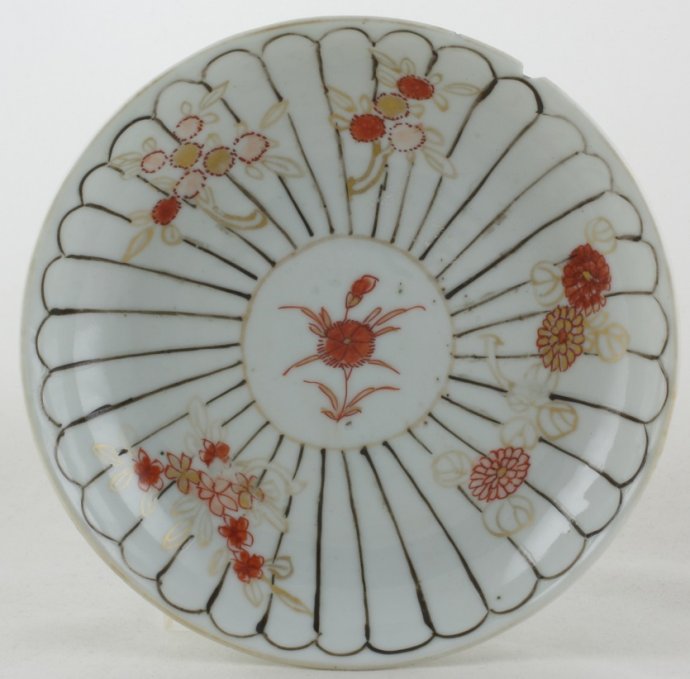
Sold Ceramics - Sold Japanese Tea, Coffee and Chocolate wares 18th Century - Page 3
Object 2011448
Saucer
Japan
1700-1720
Height of saucer 25 mm (0.98 inch), diameter of rim 139 mm (5.47 inch), diameter of footring 67 mm (2.64 inch), weight 133 grams (4.69 ounce (oz.))
Saucer on footring, spreading sides. Imari decorated in, iron-red, gold and black enamel with a central flower spray surrounded by three wide spread flower sprays on a 'kiku' leaves ground. The reverse is undecorated.
This saucer was once part of a chocolate set comprising of a saucer, a beaker and cover.
For an identically shaped, sized and decorated saucer and beaker, please see:
An identically shaped, sized and decorated saucer with beaker and cover in the collection of Augustus the Strong in Dresden and registered under the number P.O. (Porzellan Ostasien) 728 a - c., please see;
Condition: A frit and a chip to the rim.
References:
SKD Online collection, PO. 728 a - c.
Price: Sold.

Sold Ceramics - Sold Japanese Tea, Coffee and Chocolate wares 18th Century - Page 3
Object 2011259B & 2011259C
A pair of tea bowls and saucers
Japan
1700-1730
2011259B: Height of tea bowl 32 mm (1.26 inch), diameter of rim 68 mm (2.68 inch), diameter of footring 30 mm (1.18 inch), weight 48 grams (1.69 ounce (oz.))
2011259C: Height of tea bowl 32 mm (1.26 inch), diameter of rim 68 mm (2.68 inch), diameter of footring 29 mm (1.14 inch), weight 38 grams (1.34 ounce (oz.))
2011259B: Height of saucer 23 mm (0.91 inch), diameter of rim 122 mm (4.80 inch), diameter of footring 61 mm (2.40 inch), weight 89 grams (3.14 ounce (oz.))
2011259C: Height of saucer 23 mm (0.91 inch), diameter of rim 123 mm (4.84 inch), diameter of footring 61 mm (2.40 inch), weight 102 grams (3.60 ounce (oz.))
A pair of tea bowls and saucers on footrings, slightly everted rims. Imari decorated in underglaze blue, iron-red, gray, yellow and black enamel with gold with a central flower spray surround by a double underglaze blue band. On the sides two hart-shaped reserves one filled with a flowering chrysanthemum spray the other with a flowering peony spray both on a golden ground and alternating with riverscapes with pagodas, trees, mountains and waterfalls. On the rims bands with up and down turned lotus leaves filled with lines. On the reverses two widespread flower sprays, near and on the footrings three concentric bands in underglaze blue. On the bases a single flower spray. The tea bowl is decorated en suite.
The decorative style on this teacup and saucer is very similar to that used on other, earlier sold, Japanese Imari tea ware. The translucent enamel colours, the zig-zag lines-pattern borders and the reverses with the three widespread flower sprays are all very similar. This could indicate that these may be the product of a single workshop but may or may not be the product of a single kiln, specialised in these high-quality tea wares. Judging by Dutch 18th century sales and inventories, Japanese porcelain was quite expensive at the time and even more highly valued than its Chinese counterpart.
For a identically shaped sized and decorated, sold, tea bowl and saucer, please see:
Conditions:
2011259B Tea bowl: Perfect.
2011259C Tea bowl: Perfect.
2011259C Saucer: Some fine crazing to the glaze caused during the cooling down process after the firing process.
2011259C Saucer: Some fine crazing to the glaze caused during the cooling down process after the firing process.
Price: Sold.

Sold Ceramics - Sold Japanese Tea, Coffee and Chocolate wares 18th Century - Page 3
Object 2010296
Teacup and saucer
Japan
1700-1730
Height of teacup 39 mm (1.54 inch), diameter of rim 66 mm (2.60 inch), diameter of footring 26 mm (1.02 inch), weight 38 grams (1.34 ounce (oz.))
Height of saucer 20 mm (0.79 inch), diameter of rim 110 mm (4.33 inch), diameter of footring 55 mm or (2.17 inch), weight 60 grams (2.12 ounce (oz.))
Teacup and saucer on footrings, slightly everted rims. Imari decorated in underglaze blue, iron-red, gold and a light-pinkish gold wash with flowering plants and a white hare running away from foaming waves. The teacup is decorated en suite.
The hare is associated with the moon and old age. Legends says that the doe conceives by running on the waves on the 18th day of the 8th month when the sky is clear and the moon is reflected in the water, by licking the fur of the male during the same period or simply by gazing at the moon this may explain the wavy lines on this teacup and saucer. Another version of the legend tells of a white hare on the island of Oki wanted to go to the mainland but as he could not swim, he cunningly asked a number of crocodiles to line up in the water, under the pretence of counting them to see if there were more crocodiles in the sea than hares on Oki. He had almost reached the shore by jumping across their backs, when the last crocodile saw through his deception and snapped off all his fur before the hare leapt ashore. (Arts 1983, pp.113-114), (Jörg 2003/1, pp.117-118)
For a similarly decorated bowl, please see:
Condition teacup: A tiny fleabite to the inner rim.
Condition saucer: A shallow glaze chip to the outer rim of the saucer.
References:
Jörg 2003/1, cat. 126, 247 & 247a
Price: Sold.
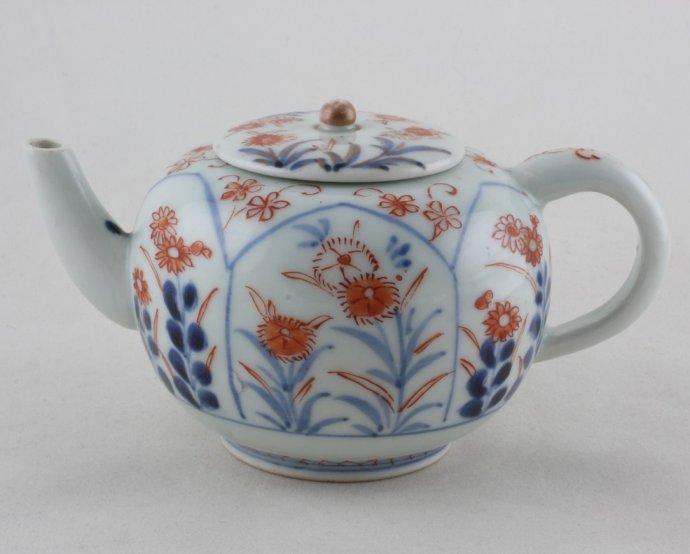
Sold Ceramics - Sold Japanese Tea, Coffee and Chocolate wares 18th Century - Page 3
Object 2012375
Teapot
Japan
1700-1720
Height with cover 75 mm (2.95 inch), height without cover 64 mm (2.44 inch), diameter handle to spout 129 mm (5.63 inch), diameter of mouthrim 40 mm (1.57 inch), diameter of footring 45 mm (1.77 inch), weight with cover 213 grams (7.15 ounce (oz.)), weight cover 26 grams (0.92 ounce (oz.))
Teapot of globular shape on footring, curved handle and short, slightly bent spout. Domed cover that is larger than the mouth. Round knob. Imari decorated in underglaze blue, iron-red and gold. Imari decorated in underglaze blue, iron-red and gold on each side with flowering chrysanthemum plants in a lotus-petal panel flanked by flowering carnation plants in lotus-petal panels On the other side flowering carnation plants in a lotus-petal panel flanked by flowering chrysanthemum plants in lotus-petal panels Round the mouthrim groups of flower sprays. Round the foot an ascending pointed lotus leaves-patterm border. On the handle a floret between scrolls. On the cover two flowering chrysanthemum plants opposite two flowering carnation plants.
These teapots were probably made for export, although the decoration is not very European, while the spout is very blunt. Those with a more elongated or curved spout seem to be more akin to the European teapot, but their shape was probably inspired by the Chinese teapot of the 16th century, which looked like the European teapot but was much smaller. It had a handle at the side, a spout opposite to it and a lid. (Arts 1983, p.53)
The wide, overlapping cover without a flat rim, breaking the line of the curving body, is unusual.(Jörg 2003/1, p.196)
Condition: Firing flaws to the tip of the spout and cover.
References:
Price: Sold.

Sold Ceramics - Sold Japanese Tea, Coffee and Chocolate wares 18th Century - Page 3
Object 2012327
Teacup and saucer
Japan
1700-1730
Height of teacup 41 mm (1.77 inch), diameter of rim 75 mm (2.95 inch), diameter of footring 35 mm (1.30 inch), weight 52 grams (1.80 ounce (oz.))
Height of saucer 22 mm (0.83 inch), diameter of rim 124 mm (4.69 inch), diameter of footring 70 mm (2.72 inch), weight 92 grams (3.56 ounce (oz.))
Teacup and saucer on footrings, slightly everted rims. The saucer with a spur-mark on the base. Imari decorated in underglaze blue, iron-red and gold with a vase filled with flowers on a low table in a central roundel. On the sides three kidney shaped panels, two filled with flower heads in gold on an underglaze blue ground and one with various flower heads, alternating with a wide spread flowering wisteria. Round the rim a zig-zag lines pattern border. On the reverse three flower sprays and on the base a single concentric band in underglaze blue. The teacup is decorated en suite.
The decorative style on this teacup and saucer is very similar to that used on other, earlier sold, Japanese Imari tea ware. The translucent enamel colours, the zig-zag lines-pattern borders and the reverses with the three wide spread flower sprays are all very similar. This could indicate that these may be the product of a single workshop but may or may not be the product of a single kiln, specialised in these high-quality tea wares. Judging by Dutch 18th century sales and inventories, Japanese porcelain was quite expensive at the time and even more highly valued than its Chinese counterpart.
Condition:
Teacup: Perfect.
Saucer: Perfect.
Reference:
Price: Sold.

Sold Ceramics - Sold Japanese Tea, Coffee and Chocolate wares 18th Century - Page 3
Object 2011292
Teacup and saucer
Japan
1700-1730
Height of teacup 34 mm (1.34 inch), diameter of rim 64 mm (2.52 inch), diameter of footring 26 mm (1.02 inch), weight 30 grams (1.06 ounce (oz.))
Height of saucer 23 mm (0.90 inch), diameter of rim 109 mm (4.29 inch), diameter of footring 45 mm (1.77 inch), weight 70 grams (2.47 ounce (oz.)
Teacup and saucer on footrings with spreading sides and rims. Imari decorated in underglaze blue with overglaze iron-red and gold with two phoenixes or pheasants in flight near a house with veranda, a flowering tree and a fence with various flowering plants. The teacup is decorated en suite with a single flower head on the base.
Condition teacup: Perfect.
Condition saucer: Perfect.
Price: Sold.
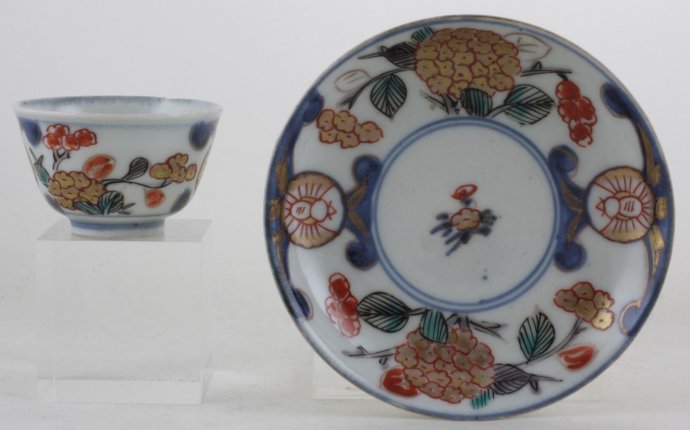
Sold Ceramics - Sold Japanese Tea, Coffee and Chocolate wares 18th Century - Page 3
Object 2012155
Tea bowl and saucer
Japan
1700-1730
Height of tea bowl 32 mm (1.26 inch), diameter of rim 50 mm (1.97 inch), diameter of footring 20 mm (0.79 inch), weight 21 grams (0,74 ounce (oz.))
Height of saucer 21 mm (0.83 inch), diameter of rim 95 mm (3.74 inch), diameter of footring 42 mm (1.65 inch), weight 45 grams (1.59 ounce (oz.))
Tea bowl and saucer on footrings slightly everted rims. Imari decorated in underglaze blue with overglaze iron-red, gold and various overglaze enamels with a single flower spray in a central roundel on the sides and rim two panels filled with flowering hydrangea. The panels are flanked by an insect in iron-red and gold on a dark blue ground with leafy scrolls in gold, The teacup is decorated en suite.
For an identically shaped, sized and decorated tea bowl, please see;
Condition: A firing flaw to the rim of the tea bowl.
Reference:
Price: Sold.
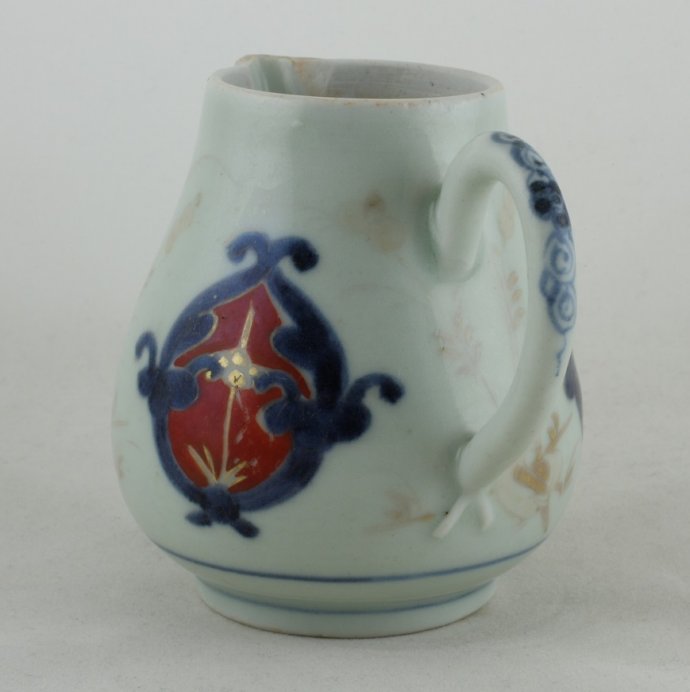
Sold Ceramics - Sold Japanese Tea, Coffee and Chocolate wares 18th Century - Page 3
Object 2012003
Milk jug
Japan
1710-1730
Height 90 mm (3.54 inch), diameter 78 mm (3.07 inch), diameter of rim 44 mm (1.73 inch), diameter of footring 45 mm (1.77 inch), weight 184 grams (6.49 ounce (oz.))
Oviform milk jug on footring, wide neck with pinched spout at the rim. Curved C-shaped handle. Rim unglazed inside for lid, now missing. Imari decorated in underglaze blue, iron-red and gold with three vertical gold sprays with pink cherries and two pink doves at foot, between each spray a floral lozenge motif in red and blue touched in gold.
Tea and or coffee sets of Japanese porcelain are extremely rare and the almost complete set in the Groninger Museum, Groningen is the only one I know of in The Netherlands. Its matching milk jug is also a rare shape in Japanese porcelain. (Jörg 2003/1, p.192)
Japanese porcelain milk jugs are, just like tea caddies, very rare, for an identically decorated tea caddy (converted into a sugar caster), please see:
For an identically decorated coffee pot and cup, please see:
For an identically shaped and sized milk jug, please see:
In all probability this tea caddy, coffee pot, cup and milk jug formed part of a set.
Condition: A small fleabite to the tip of the spout.
References:
Impey 2002, cat. 344 & cat. 352
Jörg 2003/1, p.192 & cat. 247a
Price: Sold.


 create websites
create websites